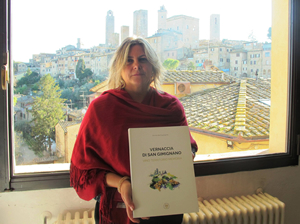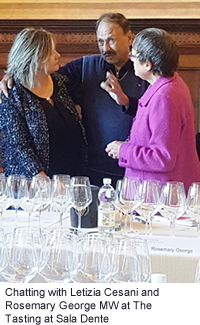|
 When I was presented the book during my visit to San Gimignano this year, courtesy Consorzio della Denominazione San Gimignano by its President, Letizia Cesani I was in a quandary. To carry it home or not was the question. Due to limited weight allowed, we prefer to carry information on Pen Drive or through URLs. Many times we are gifted books which have to be either left behind on the last day of the trip due to weight problem or simply gather dust after arrival. I am glad I sifted through the book cursorily and realised it had nuggets of information and sacrificed a couple of bottles of wine in its favour and brought it home. When I was presented the book during my visit to San Gimignano this year, courtesy Consorzio della Denominazione San Gimignano by its President, Letizia Cesani I was in a quandary. To carry it home or not was the question. Due to limited weight allowed, we prefer to carry information on Pen Drive or through URLs. Many times we are gifted books which have to be either left behind on the last day of the trip due to weight problem or simply gather dust after arrival. I am glad I sifted through the book cursorily and realised it had nuggets of information and sacrificed a couple of bottles of wine in its favour and brought it home.
Preface by Rosemary George MW
What also encouraged me was the Preface by Rosemary George MW whom I have known for over a decade and who has been to San Gimignano several times since 1973. As comfortable with Italian as with her native English language, this Londoner has already conducted comparative Guided Tastings at the historical Sala Dente, one of the most beautiful settings to conduct them.
I have attended every such tasting since I started visiting San Gimignano though I was not there in 2006 when Rosemary had conducted the comparative Tasting of San Gimignano and Chablis when four producers from Chablis had also been invited. As she says in the Preface, ‘the Chablisiens were surprised by Vernaccia’s ability to age, displaying some of the mineral and iodine notes that you also find in Chablis. A 1990 Chablis Grand Cru Blanchots faded into insignificance alongside a Vernaccia of the same vintage.’ What better testimonial for these wines! better testimonial for these wines!
Rosemary was at the Book launch when we arrived in San Gimignano and again the next day when she conducted the now traditional comparative Tasting of Vernaccia with La Clape AOC wines- sub appellation of Languedoc in South of France, made as a classic blend of Grenache Blanc, Clairette and Bourboulenc with a spattering of Rhone Valley varieties of Marsanne and Roussanne.
There could not be a more comprehensive Book on Vernaccia di San Gimignano which explores the history, cultural roots, architecture, art and its wines along with the natural landscapes. It is full of information and detailed, authentic maps and pictures not easy to find elsewhere; for me it’s a bonus that it is in Italian and English as it helps me brush up my scanty knowledge of lingua Italiana.
The book is divided into 5 chapters and 2 Appendices in Italian only. These refer to the appellation rules of wine making and a dictionary of local dialects which does not concern a casual wine lover. Suffice it to know that the DOC came into effect on May 6, 1966 and DOCG status was granted on 21 July, 1993. Amendments were made in December 2010 and 2011 with a modification in 2014 clarifying about DOP and IGP status of wines.
Chapter 1
Section 1 relates to the colourful history starting from the Etruscans in the BC era but focusing on post-1199 AD. It talks of the city of towers where 59 of the 72 towers in 1340 have been destroyed. It mentions the destruction and decline of the city after the plague of 1348, restoration projects in the 19th century and the bombings of Second World War. It also mentions that the old city was declared a UN World Heritage Site in1990.
 Section 2 is about Art in the 13th and 14th century, the churches and museums with such beautiful pictures that even if you have never been to the city or do not drink wine, you are most likely to fall in love with the city. Section 3 is about the Literature and its evolution and is unlike to stir the emotions of a newbie to the city. Section 2 is about Art in the 13th and 14th century, the churches and museums with such beautiful pictures that even if you have never been to the city or do not drink wine, you are most likely to fall in love with the city. Section 3 is about the Literature and its evolution and is unlike to stir the emotions of a newbie to the city.
Section 4 is again very interesting. Nature is of interest to all, especially wine lovers since it talks about Geology, Climate and flora and fauna. Section 5 on Economy looks at the economic structure and evolution of the landscape of 138 sq kms area and official population of 7,800 people, 1000 of whom live in the walled city-Centro which is the Heritage site. Of the 13,000 hA land in the municipality about 5600 are used for agriculture and 1900 hA as vineyards. There are 170 companies 70 of which bottle their own wine.
Chapter 2
This is the key chapter relating to wine and Viticulture in Section 1 which is described in detail. Legislation is also an important Section 2 and tells you all you need to know about the Appellation laws. The Consortium formed in July 1972 is run by a Board of Directors and is headed by a producer elected as the President for 3 years. Letizia Cesani is in her third term since 2009 (ending 2018). There are 115 members including co-operatives; 58 of these are bottling under their own brands.
Section 4 about Ampelography talks about Vernaccia grape variety at length while Section 5 on Pairings dwells on food pairings as also the use of the wine in cooking.
Chapter 3
This chapter is on various areas of production- the Territory is so detailed and precise that it would make it a Reference Book for decades. In an attempt to zone the area, the municipality has been sub-divided into  28 units (unitá). Google maps have been used to establish composition and origin of each of these units. The Carta Geologica d’Italia 1:100,000 has also been deployed. Each unit is described on the right side of the page with a beautiful, eye riveting picture on the left hand. 28 units (unitá). Google maps have been used to establish composition and origin of each of these units. The Carta Geologica d’Italia 1:100,000 has also been deployed. Each unit is described on the right side of the page with a beautiful, eye riveting picture on the left hand.
I visited Cecchi Winery in Montaùto while in San Gimignano. The Book shows me a beautiful picture of the commune with the winery, the church and the beautiful vineyards as one can see from the old city of San Gimignano. It tells me ‘it has 222.93 hA vineyard area, at 183-267m elevation and is the smallest in the southern half of San Gimignano. One third of the surface is covered in quality estates. The climate is hot ventilated with significant sunlight. The village has Pliocene (around 3-5 million years old) sand typical of Southern municipality.’
Chapter 4
The chapter Memories is about 12 people from the area who have been the most important players involved in a senior civic authority or producer capacity and have influenced the winemaking of the area to what it is today, including the current President Letizia Cesani and a couple of Past Presidents. They have all toiled hard to make San Gimignano reach the level of quality and popularity it has today. It is a good way to read about them in your spare time and look at their style of functioning and the contributions they have made for the wine  legacy. legacy.
Chapter 5
The chapter lists 50 vintages from 1966 when the DOC was formed, till 2015. It gives the temperature data, rains, sunny days and the quantity produced etc; once again the data provided though not very accurate for some of the years, gives very interesting and fairly accurate information.
The 237-page 30*20 book using high quality, heavy Art Paper and excellent professional photography, could well be a coffee table book as well, if it had a hard cover. Besides, from a personal experience, I can add that the amount you may like to use it as a source material or just for an occasional read with a glass of wine, if you love San Gimignano, it would be better off in a hard cover as the protection. Of course it would also look nicer lying on the table.
Vernaccia di San Gimignano (Vino Territorio Memoria) -the oversized Book is a very interesting and useful Reference book by a wine journalist, author and historian Armando Castagno; and at €30, worth the buy for inquisitive wine connoisseurs. As Letizia Cesani, President of the Consorzio Denominazione della Vernaccia San Gimignano says, ‘it is not a book that crystallizes the present and narrates a story that was, but one that bears the seeds for the Vernaccia di San Gimignano.’ And the book has a long shelf life!
For one of the earlier related Articles this year, please visit
Please write to the Consorzio della Denominazione San Gimignano at berti@vernaccia.it for further details on the book.
Subhash Arora |